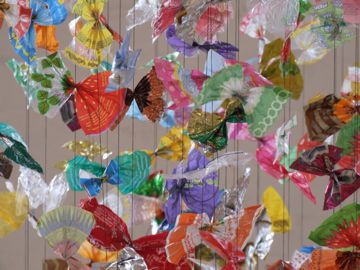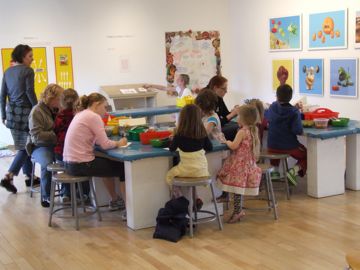Below is the second part of my conversation with Laura Thompson, Director of Exhibitions and Education at Kidspace (part one of the interview can be found here). Many thanks to Laura and the staff at Kidspace for an exciting and entertaining visit on March 20th!
Joe Fusaro: Kidspace works within MASS MoCA and develops programs in a close relationship with The Clark and Williams College of Art. One would think that the three museums in such close proximity would be in competition with one another for visitors, but it sounds like MASS MoCA has a great relationship with The Clark and WCMA. What do you enjoy most about the partnership with these museums?
Laura Thompson: The partnership with the three museums really is beneficial to the schools. As part of their Kidspace program, the students also visit MASS MoCA, WCMA, and The Clark. There they follow up on themes addressed in Kidspace exhibitions or utilize their visual literacy skills in different ways or in different contexts. In such a small community, it is wonderful to be able to offer the schools numerous engagements with the arts.
JF: How is Kidspace aware of the themes and questions students are studying in schools? Do you look at curriculum and help find ways for Kidspace to fit into the overall plan?
LT: Kidspace is an integral partner of the local schools. We work closely with classroom and art teachers, as well as administrators and coordinators to develop our ideas for exhibitions and programs. We review the schools’ curriculums and even their text books. Through training sessions, we learn more about the specific concerns in the schools and try to shape our programs accordingly. When we are able, we hire teachers to work with us to develop the curriculum guides, which are available on our website.
The final element that contributes to our awareness of the themes students study in school is that both Shannon Toye, Kidspace Education Coordinator, and I are certified educators. We have taught in the schools and have a solid understanding of the learning standards and appropriate classroom projects.
JF: At Kidspace, it sounds like it’s all about, “Let’s look at this work and how it relates to our lives. How does it relate to what we’re working on?” vs. looking at art to learn the history of a particular artist or get a lot of facts about a particular style.
LT: Yes! And how you can even process it here. The art is all around us. In some museums, the art is in the galleries and then kids go to the basement to make something. Here, students get to make art in the gallery space.
JF: What goes into getting kids to open up and speak freely about the art when they are here?
LT: Longevity is a big part of it. By the time students are in 2nd grade, these local students have already been to Kidspace four times. That in itself lends to being comfortable. It’s also a personality thing. Shannon and Casey, two of our guides here at Kidspace, are passionate about the work. They motivate the students to open up about how they feel and encourage them to take risks.
JF: What advice do you have for teachers who want to address and work with sensitive subject matter?
LT: I would plan programs that allow for multiple perspectives. Plan programs that are not bound by rigid rules and expectations and are adjustable to the immediate needs of the schools and the student population. Think through expected responses to the topic, conduct focus groups to learn more about possible reactions, and be prepared to hear interpretations that might not have been previously considered. It goes without saying that it is important to design curriculum that encourages dialogue and offers teachers open-ended questions to help them facilitate these activities.
JF: It sounds like you really know the kids you work with. It becomes everyone’s space. Not a foreign place where there’s really big art on the walls and you can’t touch anything.
LT: Well, we do get yelled at occasionally that kids can’t touch the art. People hear “Kidspace” and the connotation is that it’s Chuck E. Cheese (laughs). We’re a professional art gallery! Teachers and parents sometimes understand interactivity very differently. Some people assume it means handling objects. We encourage good behaviors that will extend to other museums. For us, interactivity means discussing the work, discovering things and making art. We try to help teachers and parents realize that the same behavior that is expected in any museum is also expected here.
JF: Where do you hope Kidspace will be ten years from now?
LT: Over the past year since Kidspace has moved to a larger gallery (from 2400 sq ft to now 3600) in a more prestigious location outside of the entrance to the Sol LeWitt installation, we have doubled our attendance. I would like the gallery to continue to grow in terms of our ability to attract world-renowned artists, and expand our residency program in the schools. I would like to see Kidspace sharing what we have learned in our school and after school programming with other communities and use our program as the foundation of research on the impact of on-going museum and art experiences on children, to eventually form publications.
Next week…. A report on the National Art Education Association’s annual conference in Baltimore, where Art21 is facilitating programs and events with Carrie Mae Weems, The Baltimore Museum of Art, Spark KQED and presenting a special Sunday workshop about our summer institute, Art21 Educators. If you’re at the conference this weekend, stop by any of these events and say hello!





